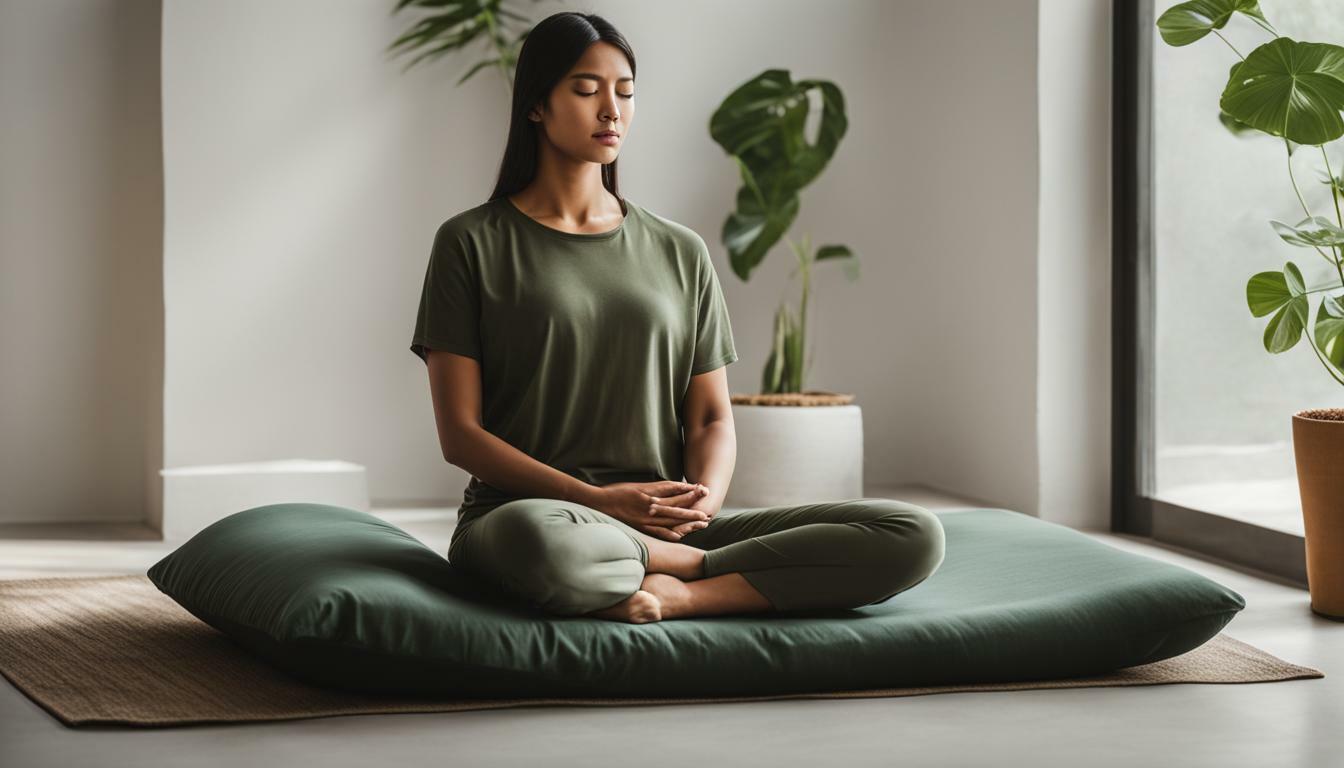Sitting on a meditation cushion is a crucial aspect of a successful and serene meditation practice. Mastering how to sit on a meditation cushion effectively can enhance your comfort and alignment, allowing for a more focused meditation experience. Whether you prefer the lotus position, half-lotus position, quarter-lotus position, or the Burmese position, using a meditation cushion can provide the support your body needs.
Key Takeaways:
- Choosing the right meditation cushion can greatly improve your sitting posture and overall comfort.
- Proper sitting posture on a meditation cushion involves a straight back, tucked chin, and gentle gaze forward.
- Using a meditation cushion helps maintain proper alignment of the head, neck, spine, and hips.
- Experimenting with different seated positions and cushion materials can help you find the most suitable option for your practice.
- A comfortable and aligned sitting position contributes to a focused and effective meditation practice.
Seated Positions for Meditation on a Cushion
To sit comfortably on a meditation cushion, it’s important to find a seated position that suits your body and promotes proper alignment. There are various positions you can try, each offering its own benefits.
One popular position is the lotus position, where you cross your legs and place each foot on the opposite thigh. This position is known for promoting stability and grounding during meditation.
The half-lotus position is another option, where one foot is placed on the opposite thigh while the other foot is tucked under the opposite leg. This position provides a balance between stability and flexibility.
If the lotus positions feel too challenging, you can try the quarter-lotus position, where one foot is placed on the opposite calf while the other foot is tucked under the opposite leg. This position offers a comfortable alternative while still maintaining proper alignment.
Seated Positions for Meditation on a Cushion
| Position | Description |
|---|---|
| Lotus Position | Both feet on opposite thighs |
| Half-Lotus Position | One foot on opposite thigh, other foot tucked under opposite leg |
| Quarter-Lotus Position | One foot on opposite calf, other foot tucked under opposite leg |
| Burmese Position | Both legs crossed, feet placed in front of the body |
Alternatively, the Burmese position involves crossing your legs with both feet placed in front of the body. This position offers a stable base while allowing for flexibility in the knees.
Remember, finding the right seated position may require some experimentation. Listen to your body and choose the position that feels most comfortable and supportive for your meditation practice.
The Importance of Using a Meditation Cushion
Using a meditation cushion can greatly enhance your meditation experience by providing comfort and promoting proper alignment. When you sit for extended periods during meditation, it’s crucial to find a comfortable posture that allows you to remain focused and relaxed. A meditation cushion, such as a zafu or a firm round cushion, can help support your body and alleviate any discomfort or strain that may arise from sitting on a hard surface.
One of the key benefits of using a meditation cushion is its ability to ensure proper vertical alignment of the head, neck, spine, and hips. This alignment allows for the even distribution of weight and relieves any pressure or tension in these areas. By maintaining a straight back and gently tucking the chin, you can further enhance this alignment and create a sense of stability during your meditation practice.
Additionally, a meditation cushion elevates the hips above the legs, which helps in achieving a more comfortable and relaxed posture. By providing support to the pelvis, the cushion allows the hips to open naturally, reducing strain on the lower back and promoting a sense of ease. This elevation also helps prevent numbness or tingling sensations that can occur when sitting for long periods in a cross-legged position on a hard surface.
Comfortable Meditation Cushion Options
| Cushion Type | Material |
|---|---|
| Zafu | Kapok fiber |
| Round Cushion | Wool, cotton, polyester |
| Zabuton | Cotton, polyester, buckwheat hulls |
When choosing a meditation cushion, consider your posture and personal preferences. A zafu is a versatile option that provides good support and is often filled with natural kapok fiber. Round cushions come in various materials, such as wool, cotton, and polyester, offering different levels of firmness and comfort. For additional support and cushioning for the legs and ankles, you can also use a zabuton, typically filled with cotton, polyester, or buckwheat hulls. Exploring different cushion types and materials will help you find the most comfortable and supportive option for your meditation practice.
Remember, the right meditation cushion can make all the difference in creating a serene and focused meditation experience. By investing in a cushion that suits your needs, you will be able to sit for longer periods with ease, allowing your mind to settle and your practice to deepen.
Tips for Proper Sitting Posture
Achieving and maintaining the correct sitting posture on a meditation cushion is key to experiencing the full benefits of meditation. When you sit on a meditation cushion, such as a zafu or a firm round cushion, it’s important to ensure proper alignment of your head, neck, spine, and hips.
To begin, find a comfortable seated position on your cushion, with your legs crossed in a position that feels natural to you. Whether you choose the lotus position, half-lotus position, quarter-lotus position, or the Burmese position, the goal is to create a stable foundation for your meditation practice.
Once you’re seated, focus on your upper body alignment. Sit with a straight back, elongating your spine, and feeling as if you’re lifting through the crown of your head. As you do this, gently tuck your chin, aligning it with the rest of your spine.
Another important aspect of sitting posture is your gaze. Softly gaze about 4 feet ahead, slightly downward. This helps to keep your attention focused, without strain or tension in your neck and eyes.
| Position | Description |
|---|---|
| Lotus Position | Cross your legs with each foot resting on the opposite thigh. |
| Half-lotus Position | Cross one leg with the foot resting on the opposite thigh, while the other leg is bent with the foot placed on the floor. |
| Quarter-lotus Position | Cross one leg with the foot resting on the opposite calf, while the other leg is bent with the foot placed on the floor. |
| Burmese Position | Sit with your legs crossed with both feet resting on the floor. |
When selecting a meditation cushion, consider factors such as posture, comfort, and materials used. Cushions filled with kapok fiber, wool, cotton, polyester, or buckwheat hulls provide different levels of firmness and support. Experiment with different cushions and positions until you find what feels most comfortable and supportive for your meditation practice.
Choosing the Right Meditation Cushion
Selecting the appropriate meditation cushion is essential for achieving optimal comfort and alignment during your meditation sessions. With various options available, it can be overwhelming to find the perfect cushion that suits your needs. Consider the following factors when making your selection:
- Posture: Look for a cushion that promotes proper posture by supporting the natural curves of your spine. This will help prevent discomfort or straining during long meditation sessions.
- Comfort: Choose a cushion that provides adequate padding and firmness. It should be comfortable enough to support your weight without sinking too much or causing discomfort.
- Materials: Consider the materials used in the cushion’s construction. Natural fibers like kapok or wool offer breathability and durability, while synthetic materials like polyester provide a more affordable option.
When it comes to meditation cushions, there are two main types to choose from: zafus and firm round cushions. Zafus are traditional Japanese cushions that are typically filled with buckwheat hulls. They offer a stable and elevated seat for cross-legged positions. On the other hand, firm round cushions provide a more versatile option and can be used in various seated positions. They are often filled with kapok or foam for added support.
Ultimately, finding the right meditation cushion requires some trial and error. Experiment with different positions and cushions to see what works best for you. Remember, the goal is to create a comfortable and supportive space that allows you to fully immerse yourself in your meditation practice. By investing in a quality cushion that suits your needs, you’ll enhance your overall meditation experience and reap the benefits of a serene and focused mind.
| Cushion Type | Features |
|---|---|
| Zafu | – Traditional Japanese cushion |
| – Provides stable and elevated seat | |
| – Filled with buckwheat hulls | |
| Firm Round Cushion | – Versatile option for different positions |
| – Provides ample support and comfort | |
| – Filled with kapok or foam |
Conclusion
By mastering the art of sitting on a meditation cushion and using one that suits your needs, you can create a serene and harmonious meditation space that supports your physical and mental well-being.
During your practice, exploring different seated positions, such as the lotus position, half-lotus position, quarter-lotus position, and Burmese position, can help you find the most comfortable position for your body.
Utilizing a meditation cushion, like a zafu or a firm round cushion, enables proper alignment of your head, neck, spine, and hips. It also elevates your hips above your legs, promoting comfort and stability.
Remember to sit with a straight back, tuck your chin slightly, and gently gaze forward about four feet ahead. These small adjustments can greatly enhance your balance and focus during meditation.
When choosing a meditation cushion, consider factors such as posture, comfort, and materials used. Options like kapok fiber, wool, cotton, polyester, or buckwheat hulls offer different levels of support and cushioning. Trying out various cushions and positions will help you find the perfect fit for your meditation practice.
With the right cushion and proper sitting posture, you can create an environment that facilitates deep relaxation and allows you to dive into the depths of your meditation practice. So, take the time to master the art of sitting on a meditation cushion and enhance your meditation experience today!
Is Proper Posture Important for Effective Meditation?
Is proper posture important for effective meditation? Absolutely. Sitting meditation tips emphasize the significance of sitting with a straight, aligned spine. Maintaining an upright posture not only helps improve focus and concentration but also aids in the free flow of energy throughout the body. By adopting a proper posture, practitioners can enhance their overall meditative experience and achieve deeper states of tranquility and mindfulness.
FAQ
How do I sit on a meditation cushion effectively?
To sit on a meditation cushion effectively, it’s important to first choose a seated position that is comfortable for you, such as the lotus position, half-lotus position, quarter-lotus position, or Burmese position. Sit on a firm round cushion, like a zafu, to ensure proper alignment of the head, neck, spine, and hips. Keep your back straight, tuck your chin, and gaze about 4 feet ahead to maintain a focused posture.
Why should I use a meditation cushion?
Using a meditation cushion, such as a zafu or firm round cushion, provides several benefits. It helps align your head, neck, spine, and hips in a vertical position, ensuring a comfortable and supported posture during meditation. Additionally, the cushion elevates your hips above your legs, enhancing overall comfort and reducing strain. It’s an essential tool for a focused and effective meditation practice.
What factors should I consider when choosing a meditation cushion?
When choosing a meditation cushion, consider factors such as posture, comfort, and materials used. Different cushions offer varying levels of support and firmness. Materials like kapok fiber, wool, cotton, polyester, or buckwheat hulls can affect the cushion’s texture and feel. It’s important to find a cushion that suits your body and provides optimal comfort for your meditation practice.
How do I achieve proper sitting posture on a meditation cushion?
Achieving proper sitting posture on a meditation cushion involves sitting with a straight back, tucking your chin slightly, and gently gazing about 4 feet ahead. This posture helps maintain balance and aligns your body for a focused meditation practice. Experiment with different sitting positions and cushions to find the most comfortable and supportive option for you.
Why is it important to master the art of sitting on a meditation cushion?
Mastering how to sit on a meditation cushion effectively is crucial for a comfortable and focused meditation practice. Proper alignment and posture contribute to a serene and deeply meditative experience. By mastering your sitting position and using the right cushion, you can enhance your practice and enjoy the benefits of meditation more fully.
How can a meditation cushion benefit my meditation practice?
A meditation cushion provides several benefits to your meditation practice. It helps maintain proper alignment of your head, neck, spine, and hips, reducing strain and discomfort. The cushion also elevates your hips above your legs, allowing for a more relaxed and comfortable sitting position. Ultimately, using a meditation cushion supports a focused and peaceful meditation experience.








